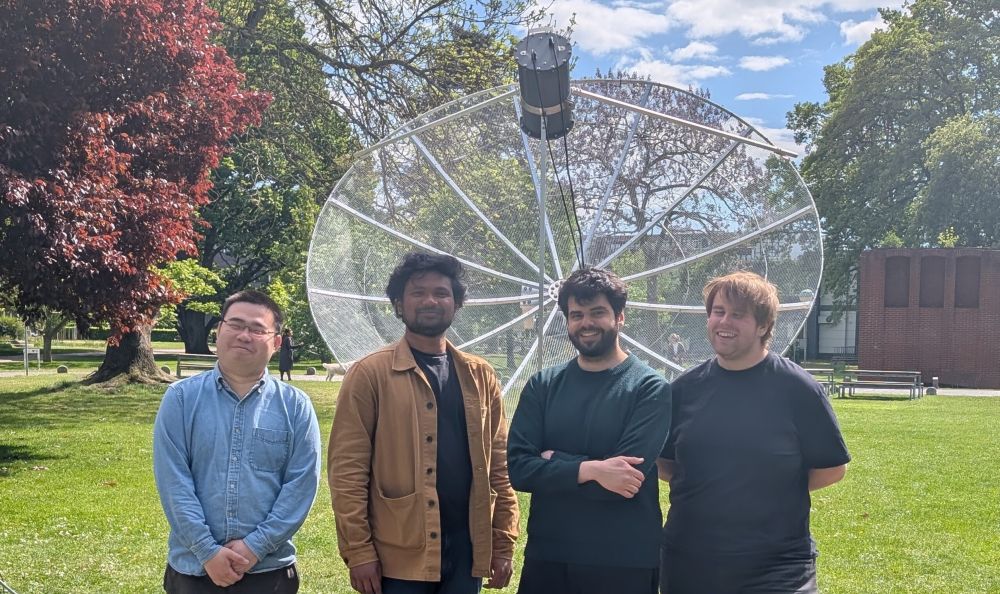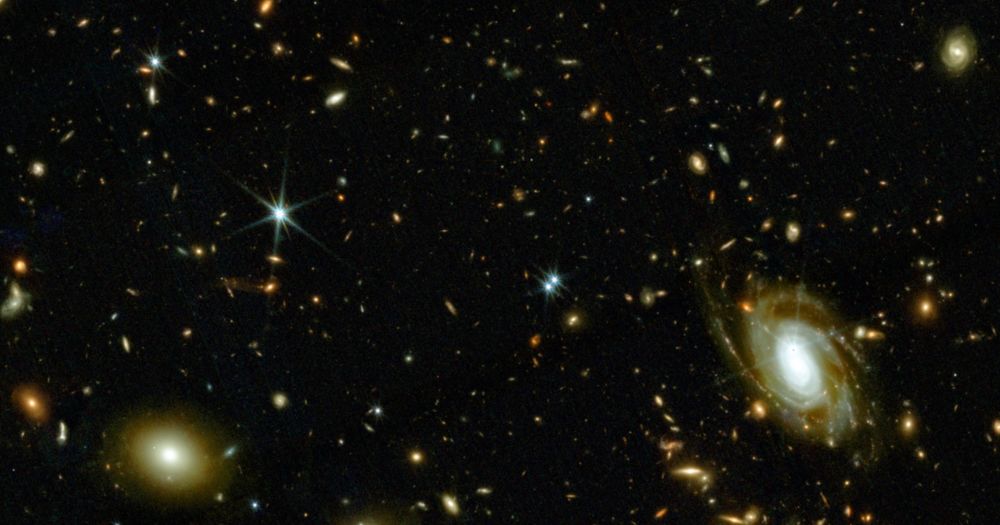Planetmæssigt kommer Saturn og Neptun op tidligt. Neptun kræver dog en kikkert, men står lige ved siden af Saturn
Jupiter og Venus som bliver flottest, også lige ved siden af hinanden (1°), står op ca. 2:30.
11.08.2025 09:07 — 👍 2 🔁 0 💬 1 📌 0
Punktet hvorfra meteorerne kommer (“radianten”) stiger højere op på himlen i løbet af natten, så flere stjerneskud ud på morgenen. På den anden side kommer en næsten fuld Måne også længere op og spolerer det lidt.
Så stjerneskudsmæssigt ville jeg gå efter det mest skyfri tidspunkt.
11.08.2025 09:06 — 👍 2 🔁 0 💬 1 📌 1

First light from student-built radio telescope - Cosmic Dawn Center
During the last six months, academic employee Gaurav Kumar, together with master students Kaj Grimstrup, Liazhe Li, and Omar Rashdan, have built two radio telescopes. One of them now observed its firs...
Behold the homemade 1.9 m radio telescope, built by DAWNers Gaurav, Kaj, Jiazhe, and Omar📡
The telescope received its first light last week, where the team was able to observe neutral hydrogen in the Milky Way from the institute's backyard.
cosmicdawn.dk/news/first-l...
@dg.dk
16.05.2025 10:59 — 👍 3 🔁 1 💬 0 📌 0
🌟🪐I maj byder himlen på spændende syn, især hvis du har en lille håndkikkert, skriver @anisotropela.bsky.social, @cosmicdawncenter.bsky.social i videnskab.dk👇videnskab.dk/rummet/kig-o...ev
01.05.2025 16:25 — 👍 2 🔁 1 💬 0 📌 0
I like Lyman α for many reasons, including its ability to probe reionization:
27.03.2025 15:35 — 👍 2 🔁 0 💬 0 📌 0
Amazing! I love how the long exposure lets you see the stars’ temperatures 🤩
24.02.2025 14:45 — 👍 0 🔁 0 💬 0 📌 0
Fair point :)
17.02.2025 14:12 — 👍 0 🔁 0 💬 0 📌 0
Right, if you're aiming to illustrate peak wavelength it makes sense. I just meant that O stars don't look purple to the human eye, so *personally* I would prefer a Planckian locus color scheme :)
17.02.2025 11:41 — 👍 0 🔁 0 💬 1 📌 0
Nice! Is that all 1½ billion stars (or how many the full sample is)?
One comment: Personally I prefer HR diagram with "real" colors, i.e. how it would look to the human eye. Blackbodies tend to be red below a few 10³, white at T☉, and saturate at a pale blue above ~10⁴ K. And never green or violet.
17.02.2025 11:04 — 👍 1 🔁 0 💬 1 📌 0
More like STONEDWACK (aSTrONomErs Don't understand hoW ACronyms worK).
17.01.2025 09:21 — 👍 1 🔁 0 💬 0 📌 0
…then proceeds to hit the Klein bottle.
16.01.2025 13:16 — 👍 0 🔁 0 💬 0 📌 0
Ha ha ha I was somewhat confused 😄
03.01.2025 23:26 — 👍 2 🔁 0 💬 0 📌 0
Jeg fik engang at vide, at jeg var tabt bag af en vogn…
30.12.2024 10:13 — 👍 1 🔁 0 💬 0 📌 0
You might be consistent, but you’re incomplete. Unrecoverably sick 🔥
30.12.2024 10:12 — 👍 2 🔁 0 💬 1 📌 0
With four kids, they need all the support they can get 😓
20.10.2023 15:08 — 👍 2 🔁 0 💬 0 📌 0
I think I have four different Dinosaur Comic T-shirts :)
25.09.2023 20:41 — 👍 0 🔁 0 💬 0 📌 0
I love them! But… has it really been 20 years… 😬🫠
I just turned old…
25.09.2023 20:38 — 👍 1 🔁 0 💬 2 📌 0
3/3
I describe how astrophysics is hard because of the huge span of timescales, but easy because of the huge span of timescales.
There's also an account of the first ~half year of galaxy observations with James Webb.
And lots of illustrative figures that you can use in your talks👍🏽
07.09.2023 06:45 — 👍 0 🔁 0 💬 0 📌 0
2/3
Context:
The article is a chapter in a multidisciplinary anthology, "Multiplicity of Time Scales in Complex Systems", aimed at non-astronomer scientists, but may also be fun for astro-students.
And "island" is also a hat-tip to "island universes"…🙂
07.09.2023 06:45 — 👍 1 🔁 0 💬 0 📌 0

1/3
I wrote my first single-author article, and I'm proud to say the a reference to Jon Bon Jovi
made it through peer review 😃
arxiv.org/abs/2309.02486
07.09.2023 06:45 — 👍 7 🔁 0 💬 2 📌 0
2/3
Context:
The article is a chapter in a multidisciplinary anthology, "Multiplicity of Time Scales in Complex Systems", aimed at non-astronomer scientists, but may also be fun for astro-students.
And "island" is also a hat-tip to "island universes"…🙂
07.09.2023 06:43 — 👍 0 🔁 0 💬 0 📌 0
I describe how astrophysics is hard because of the huge span of timescales, but easy because of the huge span of timescales.
There's also an account of the first ~half year of galaxy observations with James Webb.
And lots of illustrative figures that you can use in your talks👍🏽
07.09.2023 06:39 — 👍 0 🔁 0 💬 0 📌 0
Context:
The article is a chapter in a multidisciplinary anthology, "Multiplicity of Time Scales in Complex Systems", aimed at non-astronomer scientists, but may also be fun for astro-students.
And "island" is also a hat-tip to "island universes"…🙂
07.09.2023 06:39 — 👍 0 🔁 0 💬 1 📌 0

Never had one until I got this recently :)
06.09.2023 21:47 — 👍 2 🔁 0 💬 0 📌 0

Agree!
02.09.2023 19:24 — 👍 0 🔁 0 💬 0 📌 0
Thanks, I needed this 😭
01.09.2023 08:02 — 👍 2 🔁 0 💬 0 📌 0
Wow, amazing! I didn’t know :)
27.08.2023 18:07 — 👍 1 🔁 0 💬 0 📌 0
Where is this? We have several of these around Copenhagen, created by a Danish artist called Thomas Dambo :)
27.08.2023 15:24 — 👍 1 🔁 0 💬 1 📌 0
Dad. Author of the Cosmic Collisions books. Astrophysicist and Citizen Science fanatic @nasa. www.marckuchner.com
Professor of Political Science, University of Copenhagen. Research interests: European and Nordic Politics, Political Economy. Collector of modern ceramics, Faroese paintings and Christine Swane paintings. Lifelong fan of Bob Dylan and modernist poetry.
Amateur classical musician and astronomer. Advocate for year-round standard time.
The official profile of the DEAP-3600 Collaboration: Dark Matter experiment using Argon Pulse Shape Discrimination at SNOLAB, Canada
Theoretical neutrino and astroparticle physicist Brookhaven Lab. He/him. Partnered. Thoughts my own. Also at @jazzwhiz on the bird site
Underviser i historie og samfundsfag.
Forperson for Historielærerforeningen for stx & hf -> @historielaerer.dk
Likes might just be a 'bookmark'. Often use threads as an archive.
#skolechat #dkhist #dkøko #dkpol #uddpol #histmed #30DayChartChallenge
🇩🇰🇫🇴
Independent news from the University of Copenhagen and beyond. Got a story? Mail to uni-avis@adm.ku.dk.
Om mig: Prøver bare at gøre platformen en smule bedre. Og tester lidt forskelligt af.
Primært fokus på at lave feeds som kan bruges.
God dialog og debat er nogle af de ting, der skaber en god platform.
Cosmologist, science communicator, author, speaker, and longtime writer of Starts With A Bang.
Not the next Carl Sagan; the first Ethan Siegel.
Freelance Science Journalist. Fact Checker.
NatGeo, BBC, SciAm, NBC News, PopSci, WIRED, and others.
Hire me to fact check your book.
I post about Jewish stuff, disability, Star Trek, and The Buffalo Bills.
Jersey girl.
A Nature journal dedicated to presenting the very best research across the disciplines of astronomy, astrophysics, cosmology and planetary science.📡
www.nature.com/natastron
Professor of optics, blogger of physics, history, & pulp fiction. Generally tries to keep things light-hearted, in spite of *waves hands at everything* (he/him)
blog: https://skullsinthestars.com/
Longtime podcaster, science communicator, ex-birdbrain researcher, curious person trying to be kind & spread joy.
This Week in Science podcast (TWIS.org)
Founder Associationofsciencecommunicators.org
Signal: If you know me, find me there. Let's talk.
Interdisciplinary research network at the University of St Andrews seti.wp.st-andrews.ac.uk
Connecting science, policy, and society to prepare for the discovery of life beyond Earth
@seti_hub at the other place
Vi finansierer langsigtet forskning, der skaber ny viden og talent til gavn for det danske samfund.
We fund long-term research that creates new knowledge and talent for the benefit of Danish society. #dkvid #dkforsk #forskpol #Grundforsk
Astronomy Acres Remote Observatories (AARO) is a remote hosting observatory for astrophotographers nestled under Bortle 1 skies in rural SW New Mexico.
To learn how we can host your gear - visit https://astronomyacres.com
The Cosmic Dawn Center (DAWN) DAWN is a collaboration between the Niels Bohr Institute (U. Cph) and DTU Space, dedicated to uncovering how the first galaxies, stars and black holes formed and evolved in the early Universe.
Copenhagen 🤍
Stud.cand.scient in astrophysics 🪐








